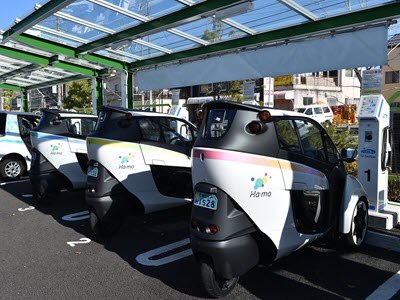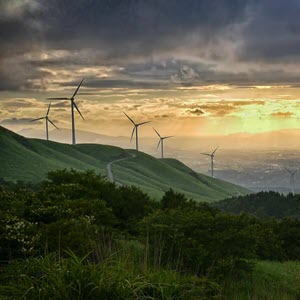Decarbonizing Japan’s Transportation Sector
Toward Net-Zero Emissions
Runsen Zhang argues that the United States and Japan are well positioned to lead the global effort to decarbonize the transportation sector.
In Japan, the transportation sector contributed 206 million tons of CO2 emissions in 2019, accounting for 18.6% of all emissions nationwide. Of these, around 177 million tons (86%) were generated from road transport. While CO2 emissions from the global transportation sector are increasing, the emissions from the transportation sector in Japan peaked at 263 million tons in 2001 and have been declining since then due to improved fuel economy and the gradual diffusion of environmentally friendly vehicles. Nevertheless, the transportation sector must remain an important focus for Japan to meet its ambitious target of carbon neutrality before 2050.
TECHNOLOGICAL ADVANCEMENTS
Next-generation vehicles (NGVs), including hybrid (HVs), plug-in hybrid (PHVs), electric (EVs), and fuel-cell (FCVs) vehicles, reduce fossil fuel consumption and CO2 emissions from the transportation sector. Currently, Japan leads the world in endorsing NGVs, particularly HVs. Of the 2.5 million new passenger cars sold in 2020, HVs accounted for just over 37%, while PHVs, EVs, and FCVs were each under 1% (0.59%, 0.59%, and 0.03%, respectively), showing the remarkable success of HVs in the Japanese vehicle market.[2] Under the Green Growth Strategy Through Achieving Carbon Neutrality in 2050 formulated by the Ministry of Economy, Trade and Industry in October 2020, the government will take comprehensive measures to make EVs account for all new passenger vehicles sold annually no later than the mid-2030s.[1]
In response, the Japanese automobile industry is accelerating the shift to environmentally friendly NGVs. The major automobile manufacturers have adopted diverse strategies to release vehicles featuring different technologies. Toyota announced a plan to sell 5.5 million electrified vehicles globally and to offer an electrified option for every car model by 2025.[3] Honda is striving to electrify two-thirds of its global automobile sales by 2030.[4] Nissan plans to make 50% of global car sales electric and hybrid by 2030.[5] However, the technological transformation represented by environmentally friendly vehicles is a long-term process and will require profound technological advances and considerable investment.
The role of electrification and batteries is an important component in reducing CO2 emissions, especially for light-duty vehicles. For heavier and long-distance vehicles that have proved difficult to electrify directly, hydrogen-powered FCVs are an attractive solution because the energy density of hydrogen per unit volume exceeds that of storage batteries. The domestic goal in the Strategic Roadmap for Hydrogen and Fuel Cells in Japan is to introduce 800,000 FCVs and 900 hydrogen refueling stations by 2030.[6] However, unlike internal combustion engine vehicles, EVs do not emit CO2 directly. Instead, they shift emissions from the transportation sector to the power sector if electricity is generated from fossil fuels. From a long-term perspective, then, a diversified energy mix that includes a stable, affordable supply of electricity and hydrogen generated from renewable energy is necessary for the wider use of EVs, PHVs, and FCVs.
SOCIETAL CHANGES
Technological innovation alone will not be sufficient for achieving Japan’s ambitious goal of net-zero emissions by 2050. The transformation of society, urban schemes, and human behavior will also be necessary.
Transportation management and urban planning are important supplementary policy tools. High-density, mixed-use, intensified land use is the core ideology in low-carbon urban planning. Compact cities are a precondition for designing an effective low-carbon transportation system because urban activities need to be located closer together to reduce long-distance travel and the use of private modes of transportation. In June 2020 the Act on Special Measures concerning Urban Reconstruction was amended, and a location optimization planning system was established to promote the formation of compact cities nationwide. In this system, the local government formulates a location optimization plan and establishes a residential guidance area where housing is concentrated and an urban function guidance area where stores and welfare facilities are concentrated, thereby creating an efficient city. Such lifestyle changes will have profound effects on the decarbonization of the Japanese transportation sector.
Japan has a vast, efficient public transportation network that is punctual, reliable, and widely used. But to establish a transit-oriented society prioritizing public transportation nationwide, a more accessible, safe, and comfortable system must be built to encourage more people to trust and use bus and rail instead of private travel modes, particularly in rural areas. In November 2020 the Act on Revitalization and Regeneration of Local Public Transport was amended to ensure the provision of sustainable services and address the declining public transportation system in Japan’s rural and depopulated areas.
In addition to transit-oriented development, non-motorized transportation deserves attention. An interconnected protected bike lane network and pedestrian-friendly street design can encourage households to move from their residential zones to other activity places by bicycle and foot in slow traffic corridors, which would induce a shift away from cars toward walking and cycling.
POST-PANDEMIC OPPORTUNITIES AND CHALLENGES
Adjusting to the new normal after the Covid-19 pandemic might create both unprecedented opportunities and challenges for decarbonization of the transportation sector. The telework rate in Japan increased from around 25% before the first state of emergency was declared in April 2020 to 56% by early May 2020.[7] With the rise in coronavirus cases, the Japanese government urged businesses to aim for 70% teleworking.[8] Online shopping also increased in popularity as the Japanese government urged citizens to stay at home or shelter in place. According to a March 2021 survey, around 45% of respondents in Japan reported an increase in online purchases during the pandemic.[9] A survey conducted by the Tokyo Metropolitan Government in April 2022 found that the telework implementation rate of companies in Tokyo is 62.5%.[10] According to a household consumption survey released by the Ministry of Internal Affairs and Communications, the percentage of households using online shopping reached an average of 51.9% in February 2022, and the average monthly expenditure was 17,199 yen.[11] Given these drastic lifestyle changes, remote working and online shopping are widely expected to become more entrenched than before the pandemic. Even if Covid-19 disappears, increasing time spent working from home and online shopping will help reduce fuel consumption and CO2 emissions.
However, other trends during the pandemic have adversely affected the decarbonization of transportation. While reduced demand lowered the consumption of fossil fuels, the pandemic also shrank the use of public transportation and car-sharing as more people chose private travel modes. In addition, although online shopping may reduce the demand for passenger transportation and corresponding energy consumption, it is likely to increase freight travel to deliver parcels to consumers. Since behavioral transformation and lifestyle changes are likely to reshape the transportation system and travel patterns, understanding the opportunities and challenges for the development of low-carbon transportation in a post-pandemic world is important.
Although many policy initiatives that support technological innovations and social transformation have been launched toward the goal of carbon neutrality, it is unwise to become overly optimistic about the prospects for a carbon-neutral transportation sector. The uncertainty about policy effectiveness, as well as the tradeoffs between different policies, should be considered when proposing strategies for developing carbon-neutral transportation. A balanced perspective integrating behavioral transformation and technology advances can mitigate the risks and uncertainties involved in policy implementation. Therefore, the parallel implementation of both technological and social transformation is required to achieve the goal of net-zero emissions.
After setting the ambitious target of carbon neutrality by 2050, the United States and Japan are well positioned to lead the global effort to work toward the deep decarbonization of the transportation sector. Both countries should further enhance coordination and cooperation through bilateral strategic dialogues to build more sustainable, green, and inclusive transportation systems. The United States and Japan have each developed policies to promote the research, development, and commercialization of environmentally friendly vehicle technologies, which makes this a particularly beneficial area for bilateral cooperation. Moreover, given Japan’s advancements in sustainable urban planning, it is important to expand cooperation in green infrastructure and low-carbon transportation planning.
Yet, as developed economies, the United States and Japan need to play a leading role to reduce emissions from the transportation sector without hindering economic progress. The development of green transportation technologies and solutions must also be an investment in future economic growth. To this end, the bilateral partnership between the United States and Japan for carbon-neutral transportation should promote economic development and prosperity in both countries. The United States and Japan should provide financial incentives and develop regulations to facilitate business investment in innovative transportation and energy technologies. Moreover, they must work to do so in a manner that does not hinder free competition or impede foreign investors from being involved in the development and implementation of innovative technologies.
Runsen Zhang is an Assistant Professor in the Civil and Environmental Engineering/Architecture Unit at Hiroshima University.
Endnotes
[1] Data is available from the Japan Automobile Dealers Association website (Japanese) at http://www.jada.or.jp/data/month/m-fuel-hanbai.
[2]Japan Ministry of Economy, Trade and Industry (METI), “‘Green Growth Strategy Through Achieving Carbon Neutrality in 2050’ Formulated,” December 25, 2020, https://www.meti.go.jp/english/press/2020/1225_001.html.
[3] “Toyota Aims for Sales of More than 5.5 Million Electrified Vehicles Including 1 Million Zero-Emission Vehicles per Year by 2030,” Toyota, December 18, 2017, https://global.toyota/en/newsroom/corporate/20353243.html.
[4] “Honda Strives to Electrify Two-Thirds of Global Automobile Unit Sales in 2030,” Honda, https://global.honda/innovation/technology/automobile/electric-vehicles.html.
[5] “Nissan to Make 50% of Global Car Sales Electric and Hybrid by 2030,” Nikkei Asia, November 25, 2021, https://asia.nikkei.com/Business/Automobiles/Nissan-to-make-50-of-global-car-sales-electric-and-hybrid-by-2030.
[6] METI, “The Strategic Road Map for Hydrogen and Fuel Cells,” https://www.meti.go.jp/english/press/2019/pdf/0312_002b.pdf.
[7] “Japan’s Telework Rate Still Far from 70% Target during State of Emergency,” Mainichi, April 26, 2021, https://mainichi.jp/english/articles/20210426/p2a/00m/0bu/015000c.
[8] Naoki Tsuzaka, “Government to Urge Businesses to Let 70% Work from Home,” Asahi Shimbun, July 27, 2020, https://www.asahi.com/ajw/articles/13582077.
[9] “Online Shopping Behavior during COVID-19 Pandemic in Japan 2021,” Statista, https://www.statista.com/statistics/1127680/japan-online-purchase-behavior-covid-19.
[10] Tokyo Metropolitan Government, “Telewaku jisshiritsu chousa kekka wo oshiraseshimasu! Sangatsu no chousa kekka” [Information on the Results of the Telework Implementation Rate Survey! Results for March], April 7, 2022, https://www.metro.tokyo.lg.jp/tosei/hodohappyo/press/2022/04/07/04.html.
[11]Ministry of Internal Affairs and Communications (Japan), “Kakei shouhi jyoukyou chousa: chousa kekka” [Survey of Household Consumption Status (about the Status of Online Shopping)], April 5, 2022, https://www.stat.go.jp/data/joukyou/12.html.



